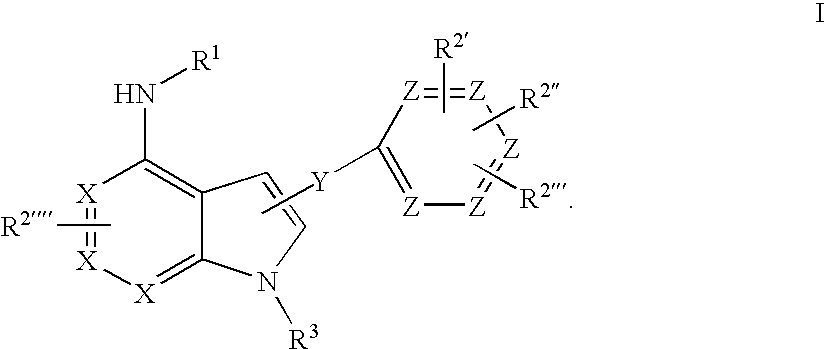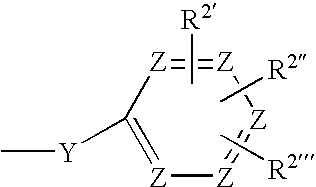Novel Azaheterocyclic Compounds as Kinase Inhibitors
- Summary
- Abstract
- Description
- Claims
- Application Information
AI Technical Summary
Benefits of technology
Problems solved by technology
Method used
Image
Examples
working examples
Example A1
Preparation of 3,4,5trimethoxy-4-(1H-pyrrolo[2,3-b]pyridin-2-yl)phenol
[0195]33 ml of lithium diisopropylamide solution (1 M in THF) are initially introduced at 0° C. under nitrogen, and a solution of 3.6 g of 3-methylpyridine 1 in 50 ml of THF is added dropwise with stirring at 0-5° C. The mixture is stirred for a further 30 minutes at the temperature indicated, and a solution of 5 g of 3,4,5-trimethoxybenzonitrile in 50 ml of THF is subsequently added. The mixture is stirred at 0-5° C. for a further 1.5 h, and finally a further 33 ml of lithium diisopropylamide solution are added. The reaction mixture is subsequently warmed at 80° C. for 2 h. For work-up, the batch is allowed to cool to room temperature, and the mixture is poured onto ice. After phase separation, the mixture is extracted a further three times with 100 ml of dichloromethane each time, the combined organic phases are dried, and the solvent is removed in vacuo. The residue is purified by chromatography over ...
example a2
Preparation of 4-chloro-2-(3,4,5-trimethoxyphenyl)-1H-pyrrolo[2,3-b]pyridine
[0199]1.5 g of 3-chloroperbenzoic acid are added to a solution of 1 g of the 7-azaindole prepared in accordance with Example 1 in 30 ml of redistilled 1,2-dimethoxyethane, and the mixture is stirred at room temperature for a further 1.5 h. Finally, 40 ml of diethyl ether are added, and the mixture is left to stir at room temperature for a further 1.5 h. The crystals formed are filtered off with suction, washed with ether and dried in air, giving 0.9 g (56%) of yellow crystals.
[0200]A suspension of 0.9 g of the 3-chloroperbenzoate is dissolved in 10 ml of water and adjusted firstly to pH=9, then to pH=12 using a saturated potassium carbonate solution and stirred at room temperature for a further 12 h, during which crystals deposit. The crystals are filtered off with suction, washed with water and dried at 80° C. for 3 h in vacuo, giving 0.5 g (85%) of beige crystals.
[0201]500 mg of the N-oxide are heated at 1...
example a3
Preparation of quinolin-3-yl-[2-(3,4,5-trimethoxyphenyl)-1H-pyrrolo[2,3b]pyridin-4-yl]amine
[0203]2 g of the compound of the formula VI prepared in accordance with Example 2 are dissolved in 50 ml of dioxane, 1.1 g of potassium tert-butoxide are added, and the mixture is warmed to 80° C. 20 mg of 2-(dimethyl-amino)ferrocen-1-ylpalladium(II) chloride dinorbornylphosphine complex and finally 1.15 g of 3-aminoquinoline are then added. After 12 h, the batch is allowed to cool to room temperature, and the reaction mixture is partitioned between ethyl acetate and water. The organic phase is dried, freed from solvent in vacuo and chromatographed on silica gel, giving 1.1 g of yellow crystals (melting point 279.5-280° C.). 300 mg of the product prepared in this way are dissolved in 20 ml of acetone and 20 ml of methanol, and the pH of the solution is adjusted to 3 using ethanolic hydrochloric acid. The deposited crystals are filtered off with suction washed with diethyl ether and dried in ai...
PUM
| Property | Measurement | Unit |
|---|---|---|
| Temperature | aaaaa | aaaaa |
| Temperature | aaaaa | aaaaa |
| Temperature | aaaaa | aaaaa |
Abstract
Description
Claims
Application Information
 Login to View More
Login to View More - R&D
- Intellectual Property
- Life Sciences
- Materials
- Tech Scout
- Unparalleled Data Quality
- Higher Quality Content
- 60% Fewer Hallucinations
Browse by: Latest US Patents, China's latest patents, Technical Efficacy Thesaurus, Application Domain, Technology Topic, Popular Technical Reports.
© 2025 PatSnap. All rights reserved.Legal|Privacy policy|Modern Slavery Act Transparency Statement|Sitemap|About US| Contact US: help@patsnap.com



